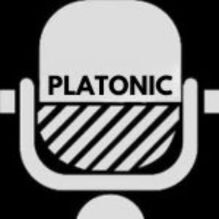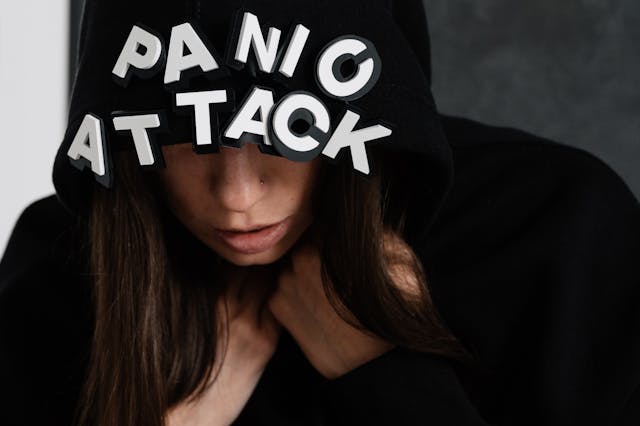Panic attack is a sudden and intense episode of fear or anxiety that overwhelms an individual, often without warning. During a panic attack, individuals experience a range of distressing physical and psychological symptoms, such as rapid heartbeat, chest pain, shortness of breath, dizziness, trembling, sweating, and a sense of impending doom or loss of control. These symptoms typically peak within minutes and can last for several minutes to hours.
Panic attacks can occur unexpectedly or in response to a triggering situation or perceived threat, such as being in a crowded space, experiencing high levels of stress, or confronting a phobia. While panic attacks are not life-threatening, they can be extremely distressing and disruptive to daily life, leading individuals to avoid certain situations or develop anxiety disorders.
It’s essential to recognize the symptoms of a panic attack and seek appropriate support and treatment. Cognitive-behavioral therapy (CBT), relaxation techniques, and medications such as antidepressants or anti-anxiety drugs are commonly used to manage panic attacks and reduce their frequency and intensity. Additionally, lifestyle changes such as regular exercise, adequate sleep, and stress management strategies can help individuals cope with and prevent panic attacks.
Panic attack symptoms
Panic attack symptoms encompass a broad range of physical, emotional, and cognitive manifestations that collectively contribute to an overwhelming sense of fear or impending doom. These symptoms typically arise suddenly and peak within minutes, often leaving individuals feeling terrified and out of control. Here’s a detailed breakdown of the various symptoms experienced during a panic attack:
Physical Symptoms:
Rapid heartbeat (palpitations)
Chest pain or discomfort
Shortness of breath or hyperventilation
Sweating or chills
Trembling or shaking
Nausea or stomach distress
Dizziness or lightheadedness
Hot flashes or sudden changes in body temperature
Numbness or tingling sensations in extremities
Emotional Symptoms:
Intense fear or terror
Feeling of impending doom
Overwhelming sense of dread
Feeling detached from reality or oneself
Fear of losing control or going crazy
Fear of dying
Cognitive Symptoms:
Racing or intrusive thoughts
Difficulty concentrating or focusing
Confusion or disorientation
Catastrophic thinking (expecting the worst outcome)
Feeling like things are unreal or dreamlike (derealization)
Feeling detached from one’s surroundings (depersonalization)
It’s important to note that not everyone experiences all of these symptoms during a panic attack, and individual experiences may vary. Additionally, the intensity and duration of symptoms can differ from person to person and from one panic attack to another. Recognizing these symptoms is crucial for understanding and managing panic attacks effectively. Seeking support from mental health professionals and learning coping strategies can help individuals navigate through panic attacks and regain a sense of control over their lives.
Panic attack vs anxiety attack
Distinguishing between panic attacks and anxiety attacks is crucial for understanding and effectively managing these distressing experiences. While both conditions share similarities, they also have distinct characteristics that set them apart. Here’s a detailed exploration of panic attacks versus anxiety attacks:
Panic Attacks:
- Onset and Duration: Panic attacks typically come on suddenly and peak within minutes, usually lasting between 5 to 20 minutes. They can occur unexpectedly or in response to specific triggers.
- Intensity: Panic attacks are characterized by intense and overwhelming fear or discomfort, often accompanied by a sense of impending doom or loss of control.
- Physical Symptoms: Physical symptoms during a panic attack can include rapid heartbeat, chest pain, shortness of breath, sweating, trembling, dizziness, nausea, and hot flashes.
- Cognitive Symptoms: Individuals may experience racing thoughts, confusion, and a sense of unreality or detachment from oneself or surroundings.
- Triggers: Panic attacks can occur without any apparent trigger, but they may also be triggered by specific situations, places, or thoughts.
Anxiety Attacks:
- Onset and Duration: Anxiety attacks typically develop gradually and may persist for longer periods, ranging from minutes to hours or even days. They may be more chronic and persistent compared to panic attacks.
- Intensity: While anxiety attacks can also be intense, the level of fear or discomfort is generally lower compared to panic attacks. Individuals may feel anxious, worried, or overwhelmed but may not experience the same level of terror as in panic attacks.
- Physical Symptoms: Physical symptoms during an anxiety attack may include muscle tension, fatigue, restlessness, irritability, difficulty concentrating, and sleep disturbances. These symptoms may be less severe than those experienced during panic attacks.
- Cognitive Symptoms: Anxiety attacks often involve excessive worry, rumination, and catastrophic thinking about future events or potential threats. Individuals may also experience difficulty controlling their anxious thoughts.
- Triggers: Anxiety attacks are often triggered by stressors such as work, relationships, or financial concerns. They may also be triggered by specific phobias or social situations.
Overall, while panic attacks are characterized by sudden and intense episodes of fear with physical and cognitive symptoms, anxiety attacks involve more persistent feelings of worry and tension that may last for longer periods. Understanding these distinctions can help individuals and healthcare professionals tailor appropriate treatment strategies for managing panic and anxiety disorders effectively.

How to stop a panic attack
Stopping a panic attack requires a combination of coping strategies and techniques aimed at managing the intense symptoms and restoring a sense of calm. Here’s a detailed guide on how to stop a panic attack:
Recognize the Signs: Understand the symptoms of a panic attack, including rapid heartbeat, shortness of breath, chest pain, dizziness, trembling, and feelings of impending doom. Recognizing these signs early can help you take proactive steps to manage the attack.
Practice Deep Breathing: Focus on slow, deep breathing to calm your nervous system and reduce the intensity of physical symptoms. Inhale deeply through your nose for a count of four, hold your breath for a moment, and then exhale slowly through your mouth for a count of four. Repeat this breathing exercise several times until you feel more relaxed.
Use Relaxation Techniques: Practice relaxation techniques such as progressive muscle relaxation, visualization, or mindfulness meditation to alleviate tension and anxiety. These techniques can help shift your focus away from fearful thoughts and promote a sense of relaxation.
Challenge Negative Thoughts: Identify and challenge negative thoughts or catastrophic thinking patterns that may be fueling your panic attack. Remind yourself that panic attacks are temporary and that you have the strength to cope with them. Replace irrational thoughts with more realistic and positive affirmations.
Grounding Techniques: Use grounding techniques to anchor yourself in the present moment and reduce feelings of dissociation or detachment. Focus on your senses by touching, smelling, or tasting something nearby. Describe your surroundings aloud or mentally to reconnect with reality.
Seek Support: Reach out to a trusted friend, family member, or mental health professional for support during a panic attack. Talking to someone who understands and validates your experience can provide comfort and reassurance.
Engage in Relaxing Activities: Engage in activities that promote relaxation and stress relief, such as taking a warm bath, listening to calming music, practicing yoga or tai chi, or spending time in nature. Find activities that help you unwind and distract yourself from the panic attack.
Consider Professional Help: If panic attacks persist or significantly impact your daily life, consider seeking professional help from a therapist or psychiatrist. Cognitive-behavioral therapy (CBT), medication, or other therapeutic interventions may be recommended to help you manage panic disorder more effectively.
By implementing these strategies and techniques, individuals can learn to manage panic attacks more effectively and regain a sense of control over their lives. It’s essential to explore what works best for you and develop a personalized plan for coping with panic attacks.
Panic attack treatment
Treating panic attacks typically involves a combination of therapeutic interventions, lifestyle changes, and, in some cases, medication. Here’s a detailed overview of the treatment options available for panic attacks:
Psychotherapy:
- Cognitive-Behavioral Therapy (CBT): CBT is considered one of the most effective treatments for panic attacks. It helps individuals identify and challenge negative thought patterns and beliefs that contribute to panic attacks. Through cognitive restructuring and exposure therapy, individuals learn to confront and manage their fears, gradually reducing the frequency and intensity of panic attacks.
- Exposure Therapy: This form of therapy involves exposing individuals to feared situations or sensations in a controlled environment. By confronting feared stimuli, individuals can desensitize themselves to triggers and learn that panic attacks are manageable.
- Mindfulness-Based Therapies: Mindfulness-based approaches, such as mindfulness-based stress reduction (MBSR) or mindfulness-based cognitive therapy (MBCT), teach individuals to cultivate present-moment awareness and nonjudgmental acceptance of their thoughts and feelings. These techniques can help reduce anxiety and prevent panic attacks.
Medication:(*Take under with doctor’s prescription only never try self medication )
- Selective Serotonin Reuptake Inhibitors (SSRIs) and Serotonin-Norepinephrine Reuptake Inhibitors (SNRIs): Antidepressant medications, such as SSRIs (e.g., sertraline, fluoxetine) and SNRIs (e.g., venlafaxine, duloxetine), are commonly prescribed to manage panic attacks. These medications help regulate neurotransmitters in the brain and can reduce the frequency and severity of panic attacks.
- Benzodiazepines: In some cases, short-term use of benzodiazepines may be prescribed to provide immediate relief from acute panic symptoms. However, due to the risk of tolerance, dependence, and withdrawal, benzodiazepines are typically used sparingly and as a last resort.
Lifestyle Changes:
- Stress Management Techniques: Learning stress management techniques, such as relaxation exercises, deep breathing, and progressive muscle relaxation, can help individuals reduce overall anxiety levels and prevent panic attacks.
- Regular Exercise: Engaging in regular physical activity can help alleviate anxiety and improve mood. Aim for at least 30 minutes of moderate-intensity exercise on most days of the week.
- Healthy Lifestyle Habits: Adopting a healthy lifestyle, including getting adequate sleep, maintaining a balanced diet, limiting caffeine and alcohol consumption, and avoiding recreational drugs, can support overall mental well-being and reduce the risk of panic attacks.
Support Groups and Self-Help Resources:
- Joining a support group or participating in peer-led self-help programs can provide individuals with valuable emotional support, coping strategies, and encouragement from others who have experienced similar challenges.
Combination Therapy:
- In many cases, a combination of psychotherapy and medication yields the best results for treating panic attacks. Working closely with a mental health professional to develop a comprehensive treatment plan tailored to individual needs can optimize outcomes and promote long-term recovery.
Overall, effective treatment for panic attacks involves a holistic approach that addresses the underlying causes, symptoms, and triggers while empowering individuals to develop coping skills and strategies for managing anxiety effectively. Collaboration between individuals, mental health professionals, and healthcare providers is essential to ensure comprehensive care and support throughout the treatment process.



I am genuinely amazed by your deep insights and stellar ability to convey information. The knowledge you share clearly stands out in every sentence. It’s obvious that you put a lot of effort into understanding your topics, and that effort pays off. Thanks for providing this valuable knowledge. Continue the excellent job! Learn more about [OnlyFans Marketing](https://elevenviral.com/onlyfans-marketing-growth-service/) https://elevenviral.com/onlyfans-marketing-growth-service/